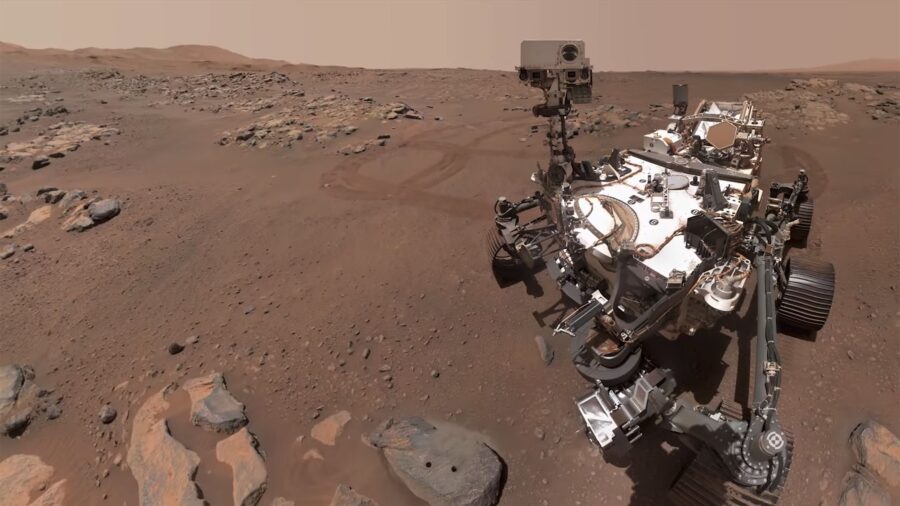NASA rethinks plan to return rare Mars samples to Earth
Apr 15, 2024, 2:48 PM

NASA is seeking innovative methods that could help retrieve samples collected by the Perseverance rover on Mars in the future. (NASA via CNN Newsource)
(NASA via CNN Newsource)
(CNN) — NASA is seeking innovative methods that could help retrieve samples collected by the Perseverance rover on Mars in the future.
The rover, which landed on Mars in February 2021, has been gathering specimens from Jezero Crater, where an ancient lake and river delta once existed on the red planet. Scientists believe the samples could help them better understand whether life ever existed on Mars.
The original design for the Mars Sample Return program, a partnership between NASA and the European Space Agency, was a complex one. The architecture involved multiple missions launching from Earth to Mars to collect the samples, and then conducting the first rocket launch from the surface of another planet to return the samples to Earth.
Concerns about the program
But there have been concerns about the program being too unwieldy due to complexity, expense and a delayed return date, which was originally expected to happen by 2031, but has been pushed after assessments by an independent review board. Budget cuts that have impacted NASA have also put the program at risk.
NASA Administrator Bill Nelson and Nicky Fox, associate administrator for NASA’s Science Mission Directorate, shared the federal agency’s response to the independent review board on Monday.
Reviews of the program have recommended that the Mars Sample return should not cost more than $5 billion to $7 billion, Nelson said. But NASA is being forced to deal with the constraints of reduced spending due to budget cuts for the 2024 and 2025 fiscal years, causing the agency to take a $2.5 billion hit, he said.
“Mars Sample Return will be one of the most complex missions NASA has ever undertaken. The bottom line is, an $11 billion budget is too expensive, and a 2040 return date is too far away,” Nelson said. “Safely landing and collecting the samples, launching a rocket with the samples off another planet — which has never been done before — and safely transporting the samples more than 33 million miles (53 million kilometers) back to Earth is no small task. We need to look outside the box to find a way ahead that is both affordable and returns samples in a reasonable time frame.”
Nelson said it’s unacceptable to wait until 2040 to return the samples to Earth because the 2040s is “the decade that we’re going to be landing astronauts on Mars,” he reiterated during a Monday press conference.
Less budget, rising costs impact Mars Sample Return
An $11 billion price tag for the program would cause NASA to cannibalize other science programs and missions, Nelson said.
Those missions include the NEO, or Near-Earth Object, Surveyor to discover asteroids that may pose a risk to Earth; Dragonfly, which will investigate the potential habitability of Saturn’s moon Titan; and missions such as DAVINCI and VERITAS to uncover the secrets of Venus. (The Venus mission names are short for Deep Atmosphere Venus Investigation of Noble gases, Chemistry and Imaging Plus and Venus Emissivity, Radio Science, InSAR, Topography, and Spectroscopy.)
While Nelson is hopeful that the budget for fiscal year 2026 won’t be as constrained, opening up more science funding for NASA, it doesn’t solve the immediate problem of how to address moving forward with Mars Sample Return.
So, the space agency is opening up a call for help.
Innovation and trusted technology
Agency officials will soon announce solicitations to NASA centers and industry to develop a new plan that combines innovation with lessons learned from proven technology, according to Fox. NASA is targeting the 2030s for a sample-return mission with less complexity, cost and risk, he said.
It’s a quick turnaround for proposals, and the agency is expecting to have answers for how best to return samples from Mars by the fall, Nelson said.
The baseline requirement of the proposals is to return the 30 scientifically curated samples Perseverance has taken from a diverse set of locations, Fox said.
“Mars is extremely important to us,” Fox said. “It’s one of the only locations that could have had life. Having said that, we understand that in order to do things faster, we may have to lower the scope of the number of samples.”
The solicitation for a new architecture for Mars Sample Return will include a range of desired specimens to return to Earth, Fox said.
“We are operating from the premise that this is an important national objective that we return the samples,” Nelson said.
He reinforced the idea that NASA did not want to terminate the program because it was deemed too critical, especially as the agency looks to land astronauts on the red planet going forward.
Meanwhile, the current decisions won’t affect the scientific plan for Perseverance’s journey on Mars, and the rover continues to collect samples as it explores the crater rim, Fox said.
Looking to the future
NASA’s Jet Propulsion Laboratory, in Pasadena, California, manages the Perseverance rover mission and other exploration endeavors on Mars.
Current efforts for the return program were underway at JPL when layoffs hit the location in February to meet the requirements of budget cuts. The new architecture that’s ultimately developed for the sample return mission will determine the scope of JPL’s management oversight, Nelson said.
The European Space Agency has also played a big role in developing the program, and Fox confirmed that the agency is still involved in discussions about the future of the program.
For fiscal year 2025, Fox said she is recommending a budget request of $200 million while NASA assesses alternative architectures, which will also enable other planetary science to continue at JPL and other NASA centers.
“To organize a mission at this level of complexity, we employ decades of lessons on how to run a large mission, including incorporating the input we get from conducting independent reviews,” Fox said. “Our next steps will position us to bring this transformational mission forward and deliver revolutionary science from Mars — providing critical new insights into the origins and evolution of Mars, our solar system, and life on Earth.”













